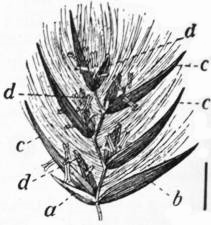usually set in at an angle with the former, sometimes trifid and
occasionally beautifully feathery (fig. 8). The lower part is most
often suppressed, and in the large group of the Paniceae awns
of any sort are very rarely seen. The awn may be either terminal
or may come off from the back of the flowering glume, and
Duval Jouve’s observations have shown that it represents the
blade of the leaf of which the portion of the
flowering glume below its origin is the sheath;
the twisted part (so often suppressed) corresponds
with the petiole, and the portion of
the glume extending beyond the origin of
the awn (very long in some species, e.g. of
Danthonia) with the ligule of the developed
foliage-leaf. When terminal the awn has
three fibro-vascular bundles, when dorsal
only one; it is covered with stomate-bearing
epidermis.
 |
| Fig. 9 (left).—Spikelet of Leersia. f, Flowering glume; p, pale. |
| Fig. 10 (right).—Spikelet of Setaria, with an abortive branch (h) beneath it. b, Barren glumes; f, flowering glume; p, pale. |
The flower with its palea is thus sessile in the axil of a floriferous glume, and in a few grasses (Leersia (fig. 9), Coleanthus, Nardus) the spikelet consists of nothing more, but usually (even in uniflorous spikelets) other glumes are present. Of these the two placed distichously opposite each other at the base of the spikelet never bear any flower in their axils, and are called the empty or barren glumes (figs. 3, 8). They are the “glumes” of most writers, and together form what was called the “gluma” by R. Brown. They rarely differ much from one another, but one may be smaller or quite absent (Panicum, Setaria (fig. 10), Paspalum, Lolium), or both be altogether suppressed, as above noticed. They are commonly firm and strong, often enclose the spikelet, and are rarely provided with long points or imperfect awns. Generally speaking they do not share in the special modifications of the flowering glumes, and rarely themselves undergo modification, chiefly in hardening of portions (Sclerachne, Manisuris, Anthephora, Peltophorum), so as to afford greater protection to the flowers or fruit. But it is usual to find, besides the basal glumes, a few other empty ones, and these are in two- or more-flowered spikelets (see Triticum, fig. 6) at the top of the rhachilla (numerous in Lophatherum), or in uniflorous ones (fig. 10) below and interposed between the floral glume and the basal pair.
The axis of the spikelet is frequently jointed and breaks up into articulations above each flower. Tufts or borders of hairs are frequently present (Calamagrostis, Phragmites, Andropogon), and are often so long as to surround and conceal the flowers (fig. 11). The axis is often continued beyond the last flower or glume as a bristle or stalk.
Involucres or organs outside the spikelets also occur, and are formed in various ways. Thus in Setaria (fig. 10), Pennisetum, &c., the one or more circles of simple or feathery hairs represent abortive branches of the inflorescence; in Cenchrus (fig. 12) these become consolidated, and the inner ones flattened so as to form a very hard globular spiny case to the spikelets. The cup-shaped involucre of Cornucopia is a dilatation of the axis into a hollow receptacle with a raised border. In Cynosurus (Dog’s tail) the pectinate involucre which conceals the spikelet is a barren or abortive spikelet. Bracts of a more general character subtending branches of the inflorescence are singularly rare in Gramineae, in marked contrast with Cyperaceae, where they are so conspicuous. They however occur in a whole section of Andropogon, in Anomochloa, and at the base of the spike in Sesleria. The remarkable ovoid involucre of Coix, which becomes of stony hardness, white and polished (then known as “Job’s tears”, q.v.), is also a modified bract or leaf-sheath. It is closed except at the apex, and contains the female spikelet, the stalks of the male inflorescence and the long styles emerging through the small apical orifice.
 |
| Fig. 12.—Spikelet of Cenchrus echinatus enclosed in a bristly involucre. |
Any number of spikelets may compose the inflorescence, and their arrangement is very various. In the spicate forms, with sessile spikelets on the main axis, the latter is often dilated and flattened (Paspalum), or is more or less thickened and hollowed out (Stenotaphrum, Rottboellia, Tripsacum), when the spikelets are sunk and buried within the cavities. Every variety of racemose and paniculate inflorescence obtains, and the number of spikelets composing those of the large kinds is often immense. Rarely the inflorescence consists of very few flowers; thus Lygeum Spartum, the most anomalous of European grasses, has but two or three large uniflorous spikelets, which are fused together at the base, and have no basal glumes, but are enveloped in a large, hooded, spathe-like bract.
 |
| Fig. 13.—Flowers of Grasses (enlarged). 1, Piptatherum, with the palea p; 2, Poa; 3, Oryza; l, Lodicule. |
Flower.—This is characterized by remarkable uniformity. The perianth is represented by very rudimentary, small, fleshy scales arising below the ovary, called lodicules; they are elongated or truncate, sometimes fringed with hairs, and are in contact with the ovary. Their usual number is two, and they are placed collaterally at the anterior side of the flower (fig. 13,) that is, within the flowering glume. They are generally considered to represent the inner whorl of the ordinary monocotyledonous

